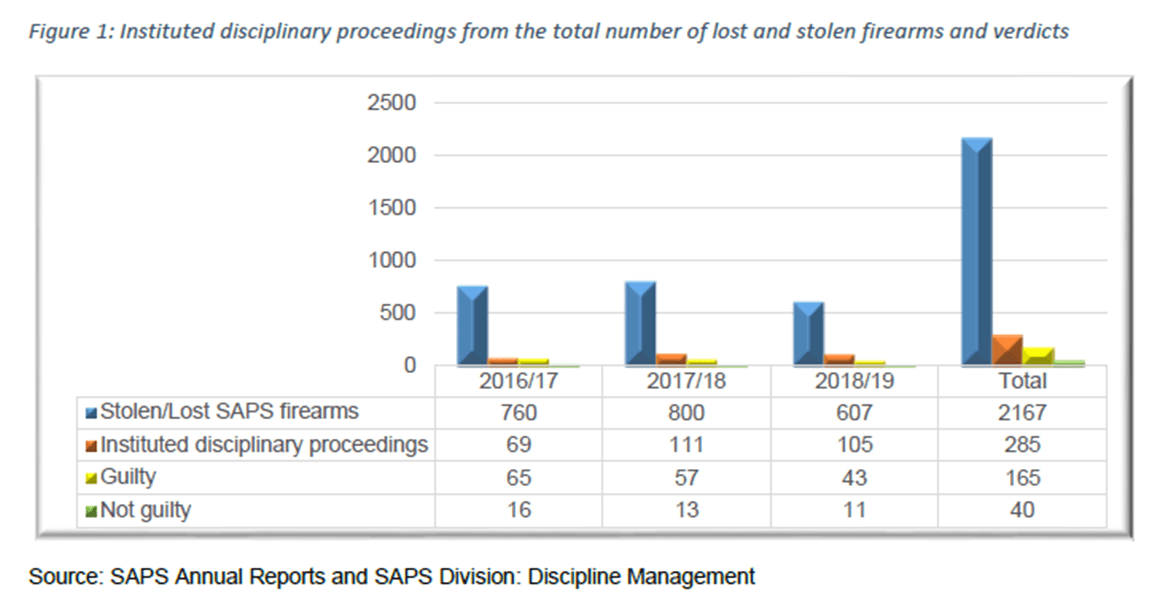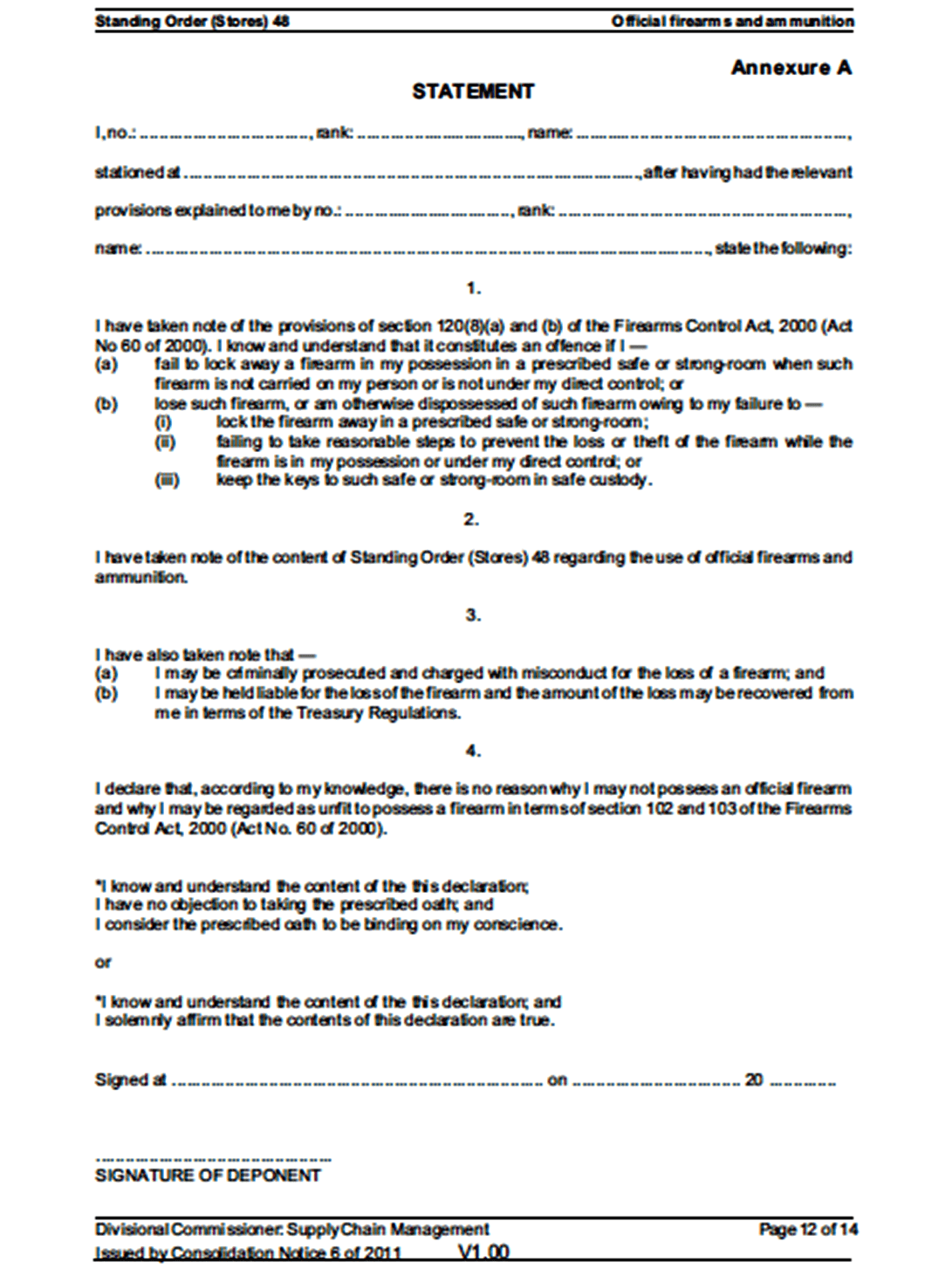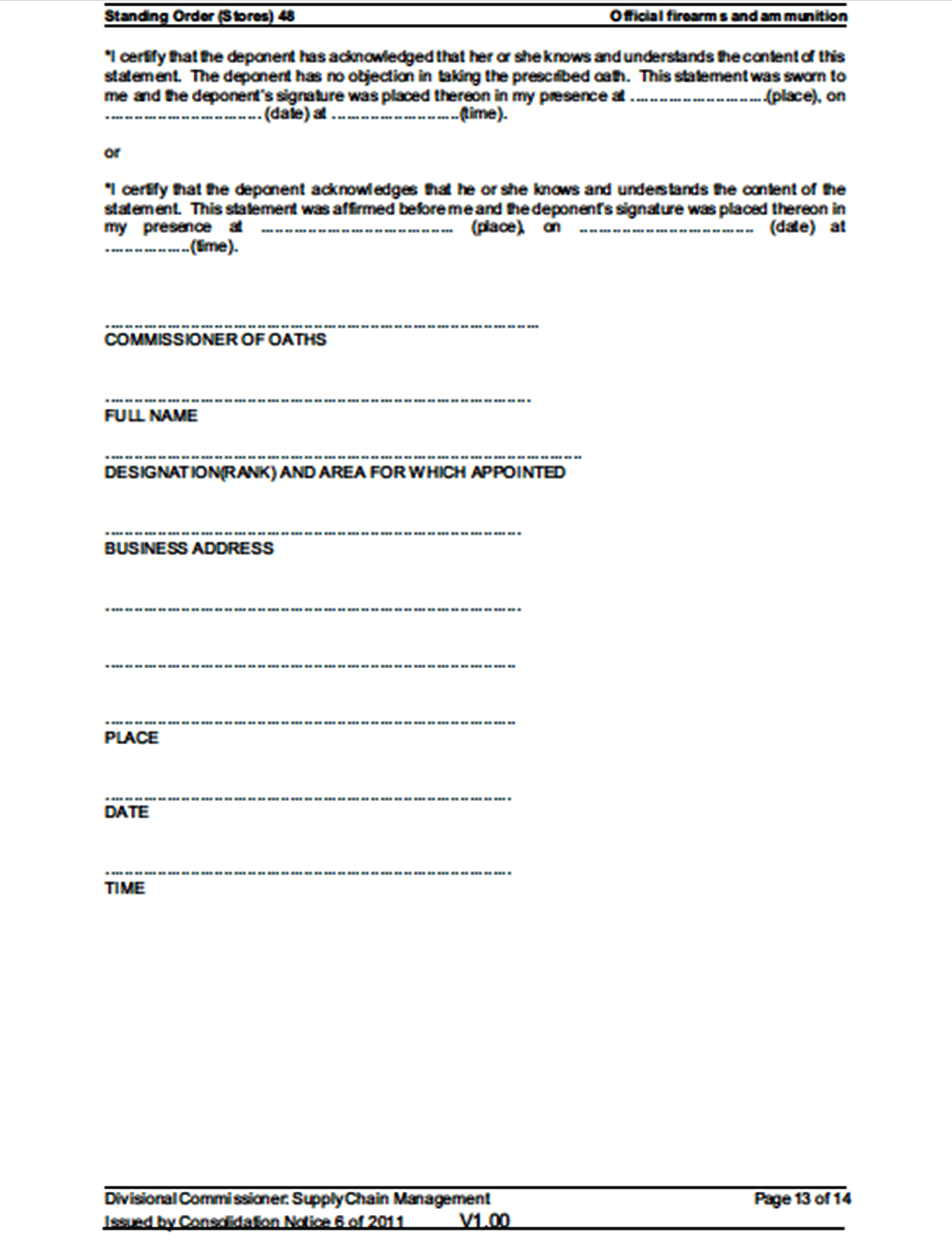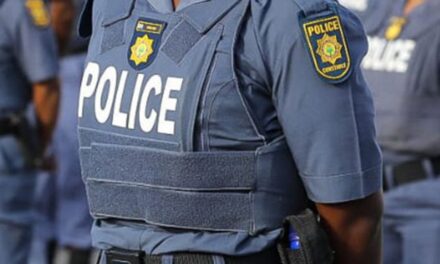FIREARMS MISSING?
Abstract
The loss of firearms in the SAPS is endemic. The problem that started decades ago persists despite a vast number of policies, control measures and threats of severe punishment that face the culprits. This abstract argues that the problem is related to the lack of proper command and control.
Keywords
Firearms, command, control, firearm losses
Author: Lt Jan de Klerk
Introduction
There are about half a million illegal firearms in the country already and more keep flowing into this pool.
The main sources of these illegal firearms are;
- firearms that have been stolen from private owners;
- firearms that have been lost or stolen from the South African Police Service (SAPS), the South African National Defence Force (SANDF) and other State departments;
It is estimated that of all the illegal firearms in the country:
- 200 000 have been stolen from or lost by the State;
- at least 150 000 have been stolen from or lost by private owners;
- 20 000 – 30 000 are homemade firearms.
These stunning revelations were made by Mr SV Tshwete Minister for Safety and Security before a Parliamentary monitoring group in the year 2000. Because of these findings, the minister introduced a comprehensive “Policy for the Control of Firearms in South Africa”. (https://static.pmg.org.za/docs/2000/appendices/000905FirearmsControlPolicy.htm)
The 23-page policy document addresses and controls all aspects of firearm licensing, possession, safekeeping and the various uses. Included here is a stipulation that “Government employees must manage firearms in a responsible manner as is expected of any member of the public with a licence.”
(Unnumbered under heading “The duties of all Government Employees possessing Firearms”.)
In 2009/2010 the SAPS reported a loss of 3 453 and recovered 1 210 (35%) of their own firearms while civilian firearms lost were 8 498 and those recovered numbered 3 985 (47%) firearms. Then Minister of Police, Nathi Mthethwa, realizing that the loss of police firearms is becoming endemic to the system, issued a media statement that Police officers who continuously and recklessly lose their firearms will be fired from the South African Police Service (SAPS). (https://www.gov.za/cops-who-lose-firearms-will-be-fired)
In addition, the ministry has begun rolling out an Integrated Ballistics Identification System (IBIS), to enable better controls entailing in theory that police officers can account for every firearm under SAPS ownership.
In March 2011, yet another Parliamentary Monitoring Group under chairperson Ms L Chikunga, expressed concern about the loss of police firearms. (https://pmg.org.za/committee-meeting/12685/)
During in loco inspections of police facilities, the committee found that there were inadequate storage facilities to safeguard official firearms at many police stations. Firearms were kept in boxes other in plastic bags and others in unbolted trunks. Often police firearms were stored together with seized firearms. Other stations would keep firearms unlabeled, untagged and unlocked in storage.
The committee’s Mr. Ramatlakane wanted to know why there seemed to be a lack of charges against police losing their firearms. In reply to the question, General Rasegkatle (SAPS) said that there was a serious problem in the control and the upgrading of records of firearms at police stations. They were rolling out a system of complete registration of SAPS weapons. It would hopefully be fully functioning in three years time. It the system would allow instantaneous access from the head office to check individual stations weapon statuses nationwide.
The extent of the problem
Five years on in 2016/2017 and 760 firearms were lost or stolen. Only 69 (9% of total) cases ended in disciplinary action.
The following year 2017/2018, one hundred and eleven (14% of total cases) disciplinary actions followed 800 stolen and lost firearms.
In 2018/19, one hundred and five (17% of total cases) of cases were referred for disciplinary proceedings out of 607 lost and stolen firearms.
https://www.safecitizen.co.za/press-room/saps-lost-guns-but-wants-to-disarm-citizens/
In 2019 Minister Bheki Cele’s figures to parliament included almost 10 million rounds of ammunition lost over 10 years, of which 500 000 went missing in one year. (Equal to about 20% of total number of rounds available to the Transvaal Republic at the start of the Boer War).
https://www.safecitizen.co.za/press-room/saps-lost-guns-but-wants-to-disarm-citizens/
Despite all the concerns and policies the unabated loss of firearms continued. In 2020 the Civilian Secretariat released the research document “Managing misconduct in the SAPS : SAPS’ Lost & Stolen Firearms. Between 2016/17 and 2018/19 (3years), members of the SAPS lost or had a total of 2167 SAPS firearms stolen. Of these, 760 SAPS firearms were stolen or lost in 2016/17, while 800 SAPS firearms were lost or stolen in 2017/18, and 607 SAPS firearms were lost or stolen in 2018/19.
http://www.policesecretariat.gov.za/downloads/reports/final_research_brief_lost_stolen_firearms.pdf
On 21 June 2021 Ian Cameron of Action Society issued a statement that the police lost or could not account for 26025 guns issued to police officers between 2005 and 2017 (12 years).
In March 2022 the South African Police Services reported that 7 331 firearms stolen over the last 10 years. Of these, only 5 170 were recovered.
The Civilian Secretariat continued their report; “The persistent trends of lost and stolen SAPS firearms is indicative of police negligence, an unsafe and mismanaged policing environment, and poor training, which ultimately contributes to the criminal pool.
“Police officers, who fail to safeguard the firearms they are entrusted with, do not abide by the SAPS regulatory frameworks on firearms control and relevant policing prescripts specifically the Firearms Control Act 60 of 2000 specific to conditions for the storage of firearms.
The Secretariat reports that only 13% of cases of lost and stolen firearms were referred for disciplinary action. The following graph is an indication of the corrective sanctions against SAPS members. Clearly, management is reluctant or ill equipped to deal with negligence or criminality in SAPS ranks.
Statistics
The 2023 portfolio report announced that the SAPS have an actual target of how many firearms can be lost (!). An astonishing statement from the very custodians of the Firearms Control Act.
“In 2022/23, 742 firearms owned by the SAPS were confirmed as stolen or lost, which is 142 more than the set target of 600. Portfolio Committee on Police is concerned that the number of lost or stolen SAPS-owned firearms is more than the set target.
“In the past five financial years, 3,405 official police firearms were stolen or went missing, while between 2005 and 2017, 26,025 firearms that were issued to police officers were stolen or could simply not be accounted for, according to a City Press report.
Accurate firearm ownership in the security industry is scant; however, in 2003 there were an estimated 58981 firearms in use by this industry. Extrapolating the target in the security industry to 2003 statistics, translates to a target of 200. However, the industry grew exponentially in recent years, therefore the target number will undoubtedly be much higher. It’s difficult to imagine that SAPS will look with the same kindness to such losses in the private sector.
Bureaucratic Controls
Although we see a plethora control measures since the release of minister Tshwete’s “Policy for the Control of Firearms in South Africa” none of these gained enough traction to make a significant impact on firearm losses in the SAPS.
In addition to the measures, we have to appreciate the existence and but noncompliance to Standing Orders (Stores) 48. Police officers are excluded from compliance to the Firearms Control Act 60/2000 (section 95 to 99) but are under instructions of SAPS Standing Orders (Stores) 48. This 14-page document specifies the procedures for control and safekeeping in minute detail. Recordkeeping and accountability entails eight stages with a paper trail of command and control. It involves the immediate commander, unit commander and/or station commander. Instructions are detailed in the issuing of firearms, the practices of handling and for the safekeeping of firearms. In addition, the Standing Orders detail the process to follow in the event of losses.
Yet the police are still losing these at the cost of innocent civilians who are robbed, maimed, even killed while only 35 cases were prosecuted and 5 convicted in 8932 cases where firearms were lost. Of those prosecuted, 46% involved SAPS members.
https://www.polity.org.za/article/8932-firearms-lost-and-stolen-from-saps-since-201112-2023-01-12
The only explanation for most firearm losses is non-compliance to existing policies and instructions.
The causes of non-compliance
The Organisation for Economic Co-operation and Development lists a number of reasons for non-compliance to regulations. The most applicable to the policing environment are listed:
- The lack of regulatory knowledge or comprehension by the target group.
People cannot comply with regulations if they do not understand what is required. Requirements are too complex to know and understand. Policymakers often feel pressure to issue new rules or expand existing ones to cover unforeseen circumstances, to close loopholes, and to address new problems.
- The willingness of the target group to comply with the rules.
Voluntary compliance is likely to be low when costs (in time, money, or effort) of complying with a rule are considered high.
- Overly legalistic regulation.
People lose confidence in regulators if they are required to comply with technical rules that do not appear to relate to any substantive purpose. Compliance rates are lower when regulation does not fit well with existing market practices or is not supported by cultural norms and civic institutions. Sometimes the whole point of issuing a rule is to counter an existing market or cultural practice.
- Failure to monitor.
A rule that is on the books, but not monitored is unlikely to elicit compliance. Random inspections among the target group have the effect of making people and enterprises constantly aware of the existence of enforcement activities and tend to reduce the likelihood of future non-compliance. However, monitoring that is not rigorous enough or not targeted at high-risk areas is less likely to be effective.
- Deterrence failure.
Regulators can face a failure of deterrence because so many kinds of business rule breaking have high rewards and low probabilities of detection. Additionally, because of limited regulatory agency resources or lack of strategy in monitoring and enforcement, non-compliance may have a low probability of detection and enforcement. The threat of enforcement will not act as a deterrent if people do not believe noncompliance is likely to be discovered or punished.
- Failures of administrative capacity.
Not only should governments rely on good drafting and enforcement practices but they should also devote resources to adequate implementation policies, aimed at making it feasible for the target group able to comply with the rules.
Conclusion
The perceived carelessness with which police officers keep custody of their firearms has been a serious problem over a long period. Although police management and political leaders are addressing the matter with the releasing of new policies and regulations, the problem does not abate. In a country plague by violence and where firearms are one of the primary instruments of unnatural deaths, firearm losses by the very custodians of firearm control should not be tolerated by the government, police management or the public at large.
Newham and Fall note that members of the service should know that there are strong systems in place to hold them accountable if they abuse their powers. The overall police disciplinary system must be strengthened so that it operates more effectively and efficiently. Managers who fail to provide proper guidance or to discipline their members must be held accountable for the actions of their subordinates.
The low percentage of disciplinary cases instituted on the loss and theft of firearms bears reference to poor management of discipline in the SAPS. it is evident that the majority of SAPS officers are exonerated of wrongdoing or negligence for the loss or theft of police-owned firearms This translates to poor consequence management in the SAPS.
Sources
Protector or predator? Tackling police corruption in South Africa, Gareth Newham and Andrew Faull, ISS Monograph Number 182
Reducing the risk of policy failure, Christine Parker, University of New South Wales, Sydney,
Dutch Ministry of Justice and Jefferson Hill of the US Office of Management and Budget.
https://www.oecd.org/gov/regulatory-policy/46466287.pdf
The Barrel of the Gun, Improving the Regulation and Control, of the use of Firearms within the
Private Security Industry in South Africa, Dr S. Gumedze, PSIRA, 2016








